Hydrangeas are large, woody shrubs that put on quite a show when in bloom between spring and fall. Their big flower clusters come in different shapes and styles. Their growth habit can be bushy or climbing. Some varieties are more sensitive to sun rays, and some hydrangea plants bloom on old wood, while others bloom on new growth. So determining exactly when hydrangeas bloom depends on the type of plant, the cultivar, and their growing Zones.
Does this cause more confusion than clarity about the timing for hydrangea blooms? Let’s put the mystery to rest by looking at the average hydrangea peak seasons by Zone. We’ll start with how it affects a plant’s bloom time when it grows on old vs. new wood.

Most hydrangea varieties bloom between spring and fall in the majority of Hardiness Zones.
©ButtermilkgirlVirginia/Shutterstock.com
Peak Blooming Seasons: Hydrangeas in Different Hardiness Zones
The peak blooming seasons of hydrangeas can vary depending on the USDA Hardiness Zone, which divides the US into regions based on average minimum winter temperatures.
Before we look at when specific hydrangea varieties produce flowers, here’s a general guide to when hydrangeas bloom by Zone:
| USDA Hardiness Zone Ranges | Hydrangea Bloom Timing |
|---|---|
| Zones 3-4 | Mid-summer to Late-summer: In these colder regions, hydrangeas typically bloom from mid to late summer, usually around July and August. Panicle hydrangeas grow well in these colder Zones. |
| Zones 5-6 | Early Summer through Fall: Hydrangeas in these areas often start blooming in late spring or early summer and continue blooming through fall. Zones 5-6 are solidly in the Hardiness Zone range of most hydrangea plant varieties, including traditional bigleaf shrubs like mopheads. |
| Zones 7-8 | Late Spring through Fall: Now we’re moving into some warmer Zones that experience longer and milder growing seasons. However, Zones 7-8 bloom times are very similar to those in Zones 5-6. Hydrangeas here begin blooming as early as late spring and continue through to fall. |
| Zones 9-10 | Early Spring to Fall: In the hotter regions of Zones 9-10, you’ll need to make sure your hydrangeas don’t get scorched by the afternoon sun. In fact, hydrangeas are rarely hardy in Zones as warm as Zone 10. So in these areas, it may be better to plant hydrangeas in moveable pots or on shady porches that get only morning sun. Hydrangeas in Zones 9-10 usually bloom from early spring to fall, depending on the cultivar. |
Different factors can influence hydrangea bloom timing.
Keep in mind that unexpected weather events and microclimates within each Zone also influence when hydrangeas bloom. And the type of hydrangea matters too! So let’s look at each hydrangea type and its peak season in its ideal Hardiness Zones.
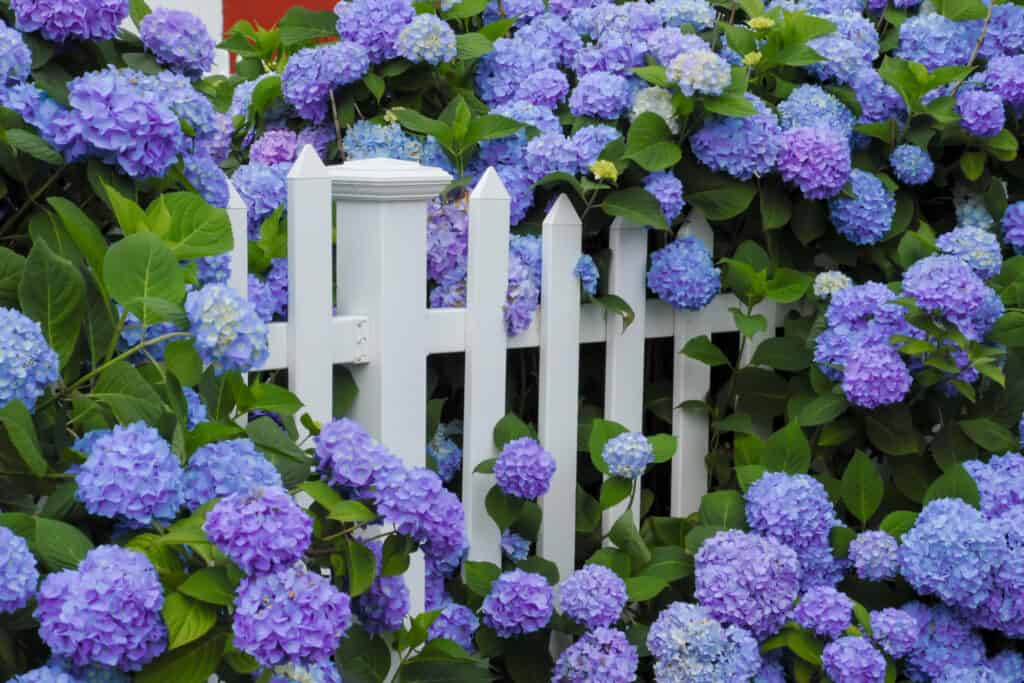
Hydrangeas that grow from old wood tend to bloom sooner than plants that grow on only new wood.
©Janice Higgins/Shutterstock.com
Old Wood vs. New Wood: Which hydrangeas bloom sooner?
Many of the modern hydrangea cultivars bloom on both old and new wood, but some of them do not. Why does it matter to know this about your plants? Because hydrangeas that bloom on old wood tend to bloom sooner. Additionally, when you prune your plants (if at all) also depends on this growth habit.
- Old Wood: Plant growth from last year
- Plants that grow on old wood tend to bloom sooner in the new season than plants that grow only on new wood. It may require covering the plants during winter to protect the old growth. This practice is most common with bigleaf hydrangeas because their buds are more delicate.
- Little to no pruning is needed. Or pruning happens right after it produces blooms and before it produces more.
- New Wood: New plant growth this year
- Plants that grow only on new wood will usually bloom later than plants that grow from old wood.
- Pruning can happen in the spring before new growth appears.
- Old and New Wood: Reblooming or Remontant Hydrangeas
- If your hydrangea cultivars bloom on old and new wood, your plant will treat you to an early round of blooms and more later in the season. These plants are called reblooming or remontant hydrangeas, which include bigleaf and mountain varieties.

The mophead hydrangea blooms between late spring and early fall.
©iStock.com/9632290_400
Mophead hydrangeas (Hydrangea macrophylla)
- Peak Bloom Season: Late spring through early fall
- Blooms On: Depends on the cultivar, but many bloom on both old and new wood.
- Hardy in These Zones: Usually 5-9 but can vary per cultivar
The mophead hydrangea is a bigleaf variety that produces large, rounded flower heads in blue, pink, or purple, depending on the pH of the soil. Also called Hortensias, mophead shrubs have toothed heart-shaped leaves and feature cluster-flower blooms up to 6 inches across.
The florets of mophead blooms are sterile, which results in a longer bloom time. Mophead hydrangeas can keep blooming from early spring through early fall in the ideal growing conditions of Zones 5-9. Also, mophead hydrangeas bloom on old and new wood, which means they can produce buds sooner than other varieties.
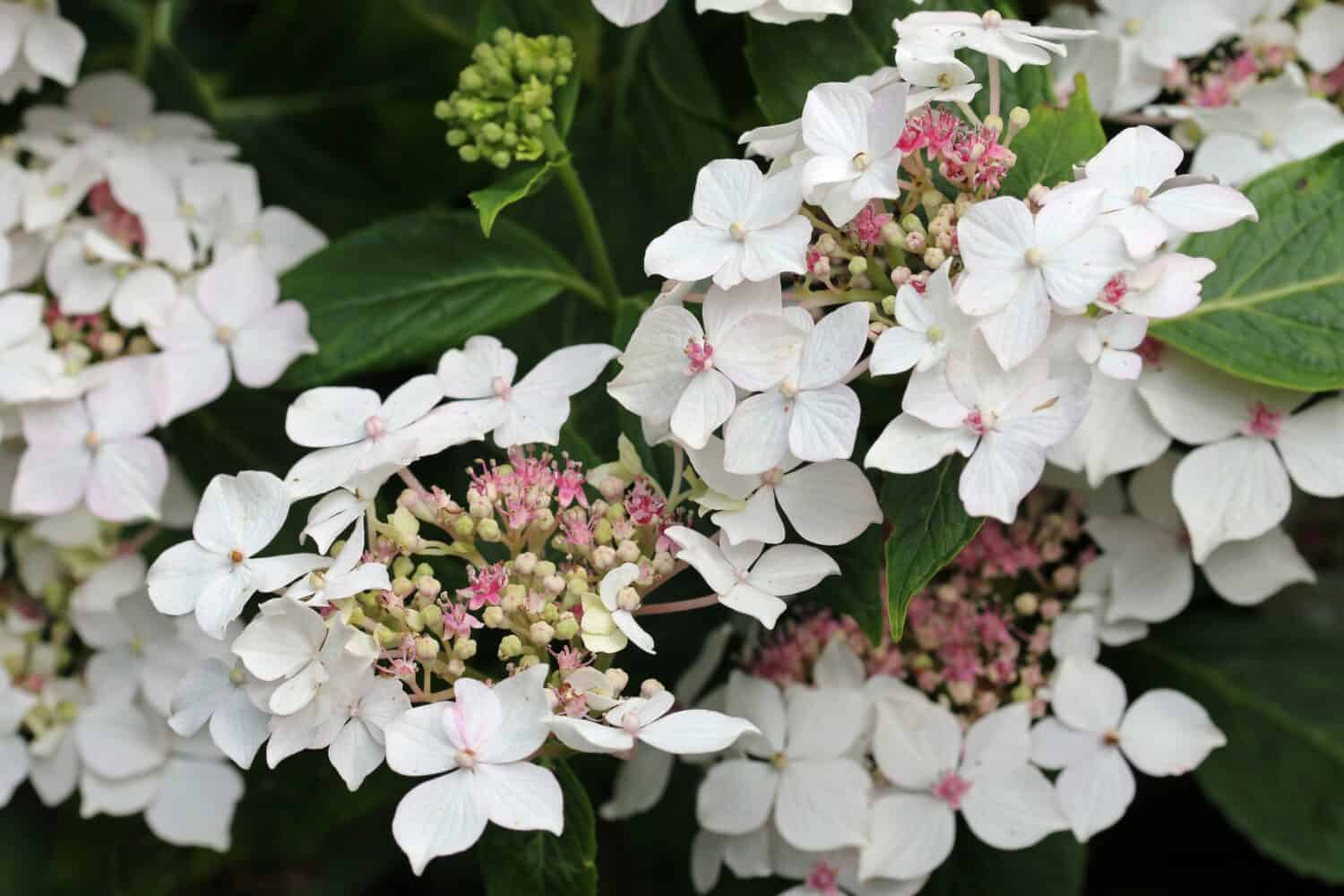
The lacecap hydrangea produces flower clusters with sterile center buds and fertile outer blooms.
©JohnatAPW/Shutterstock.com
Lacecap hydrangeas (Hydrangea macrophylla f. normalis)
- Peak Bloom Season: Early summer or fall, depending on the cultivar
- Blooms On: Depends on the cultivar, but many bloom on both old and new wood
- Hardy in These Zones: Usually 3-9, depending on the cultivar
The lacecap hydrangea is another bigleaf plant with a section of delicate and fertile flower buds in the center of its blooms. The outer ring of each lacecap flower features sterile florets just like those of mophead hydrangeas. However, lacecap hydrangea blooms last up to 4 weeks. This much shorter bloom time compared to mophead varieties is because the inner buds of lacecap flowers become pollinated.
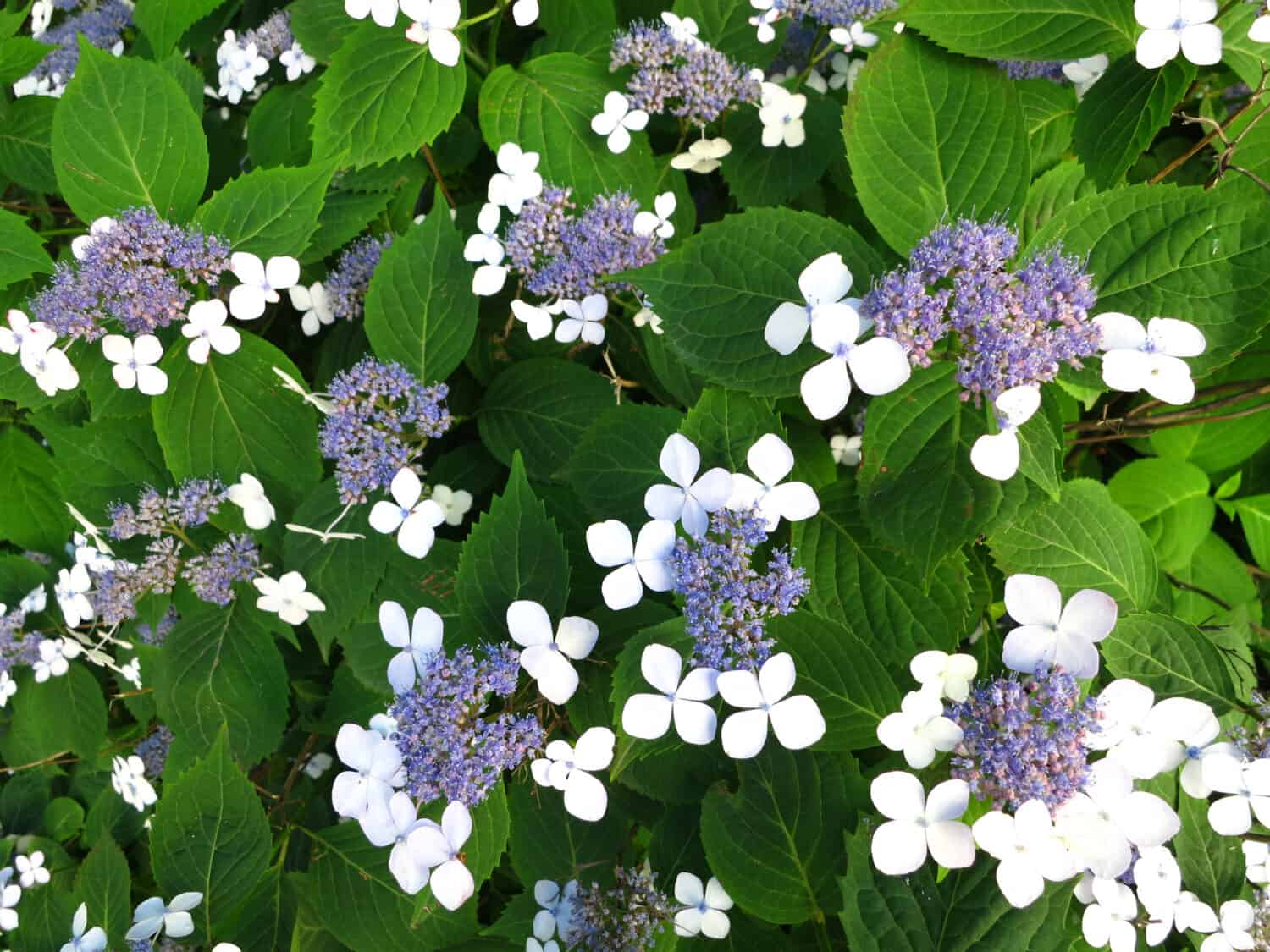
The mountain hydrangea has lacecap-style blooms and produces flowers during the summer months.
©Olga Glagazina/Shutterstock.com
Mountain hydrangeas (Hydrangea serrata)
- Peak Bloom Season: Early through late summer
- Blooms On: Depends on the cultivar, but many bloom on both old and new wood.
- Hardy in These Zones: 5-9, depending on the cultivar
Mountain hydrangeas also have lacecap blooms with fertile buds in the center and sterile florets around the outer edge. However, these lacecap-style blooms are smaller than those of bigleaf varieties.
The mountain hydrangea is a less common plant but is also a hardier shrub that can survive harsher conditions. In addition, mountain hydrangeas have a longer dormancy phase than mophead plants, so mountain hydrangeas bloom later. This advantage is welcome in changing climates where surprise frosts might kill the buds of other hydrangeas late in spring.
Mountain hydrangeas also have smaller leaves than bigleaf varieties, which means this plant needs less water by comparison.
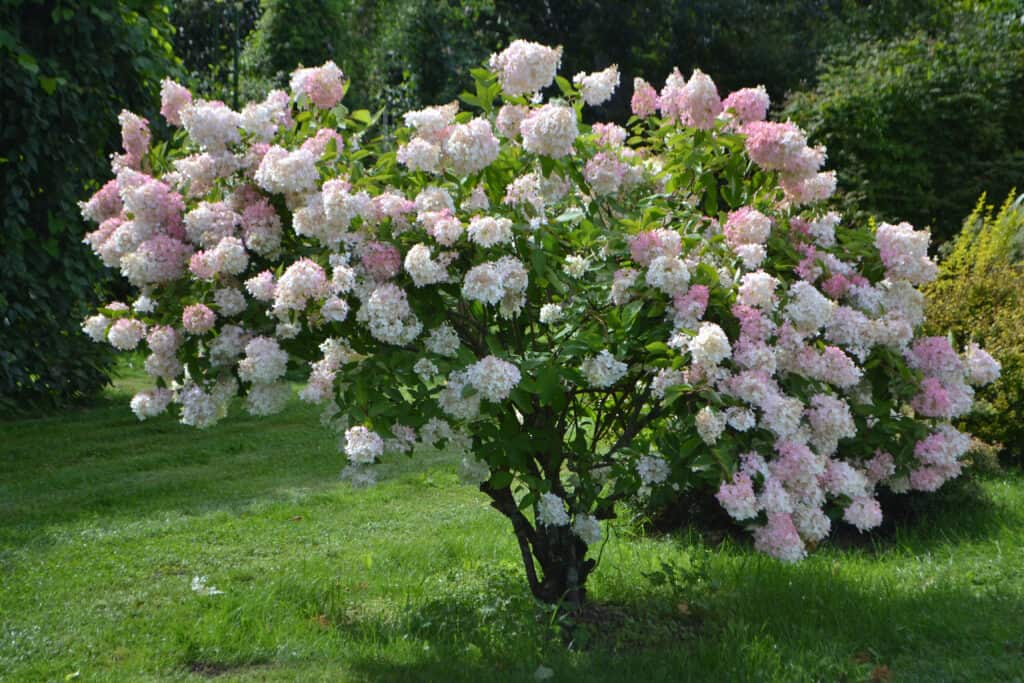
Cone-shaped panicle or “peegee” hydrangeas bloom from mid-summer through fall.
©Edita Medeina/Shutterstock.com
Panicle Hydrangea (Hydrangea paniculata)
- Peak Bloom Season: Mid-summer through fall
- Blooms On: New wood
- Hardy in These Zones: 3-8, depending on the cultivar
Panicle, peegee, or limelight hydrangeas feature elongated cone-shaped or football-shaped flower clusters. They are highly adaptable and easy to grow, so they might be the perfect type of hydrangea for beginning gardeners.
Peegee hydrangeas grow well in colder climates (as low as Zone 3) and tolerate more hours of direct sunlight than other varieties. Another difference between panicle hydrangeas and other types is that you cannot change their flower color by any means. No matter the pH of the soil, panicle hydrangeas bloom white, and then mature to pink and red. In addition, the leaves of panicle hydrangeas are smaller than mophead or lacecap varieties.
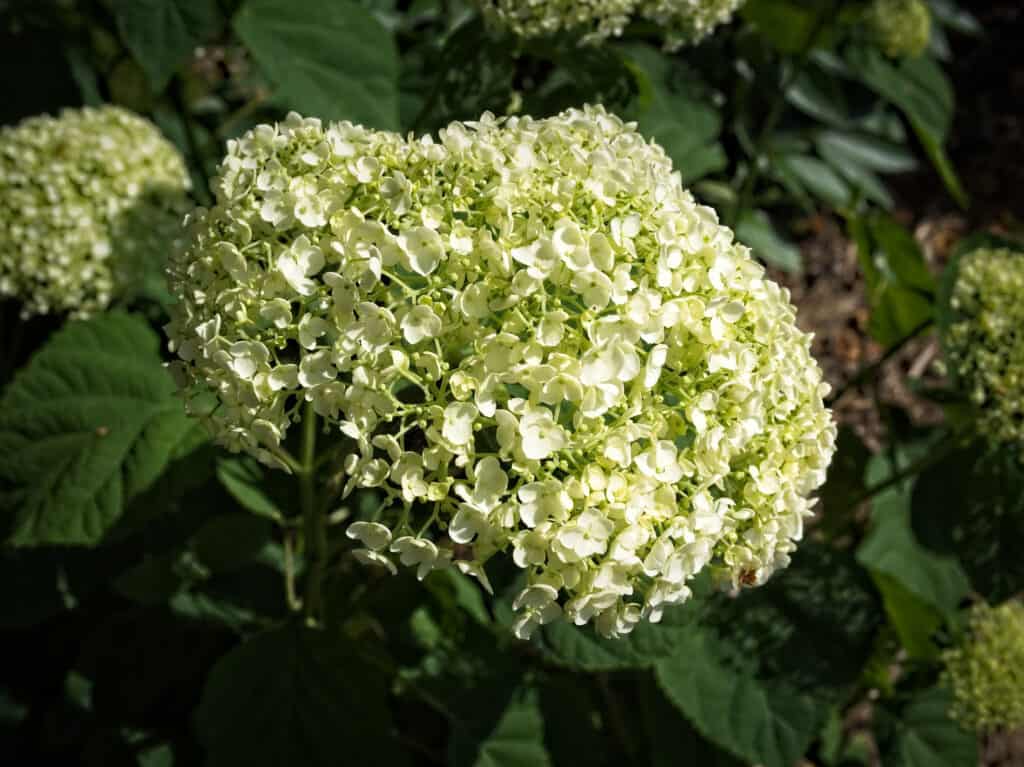
The smooth hydrangea is hardy in Zones 3-8 and blooms from early summer to fall.
©F. D. Richards / Flickr – License
Smooth Hydrangea (Hydrangea arborescens)
- Peak Bloom Season: Early summer to fall
- Blooms On: New wood
- Hardy in These Zones: 3-8, depending on the cultivar
Smooth hydrangeas are hardy shrubs that can handle colder or hotter climates than some other varieties. Most smooth hydrangeas produce cream or white flower heads similar to mophead blooms. These plants have toothed egg-shaped leaves that turn green to yellow in autumn.
Perhaps the most famous smooth hydrangea cultivar is ‘Annabelle’ because of its hardiness and huge, showy white blooms in different climates. And it’s an heirloom plant, so it has proven itself a consistent performer as an ornamental landscape shrub.
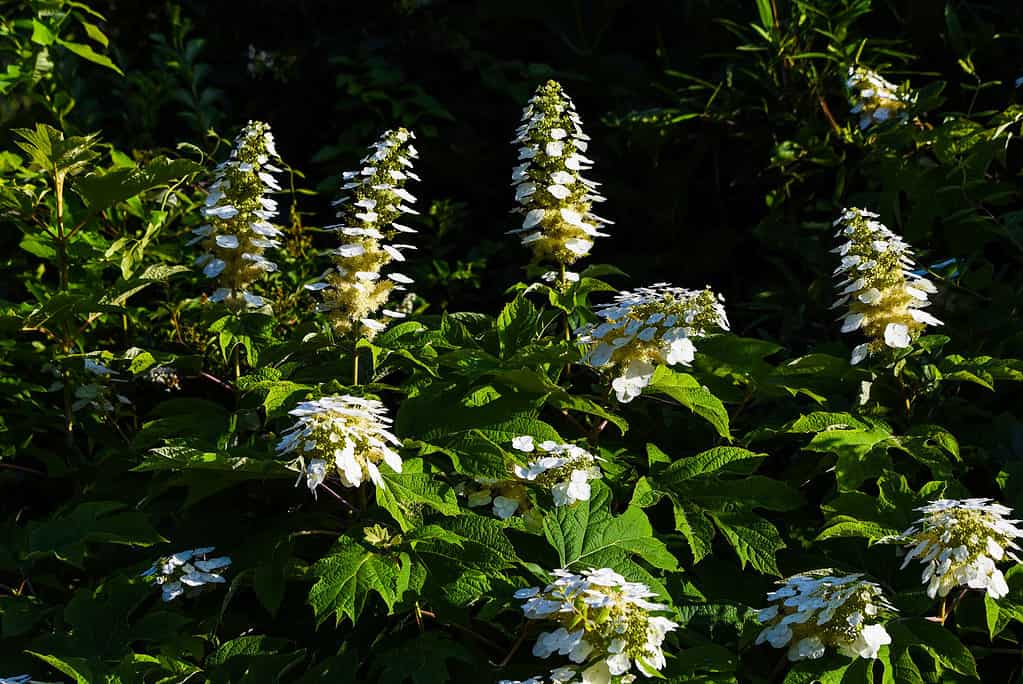
The oakleaf hydrangea produces its cone-shaped blooms from spring through fall in Zones 5-9.
©iStock.com/undefined undefined
Oakleaf Hydrangea (Hydrangea quercifolia)
- Peak Bloom Season: Spring through fall
- Blooms On: Old wood
- Hardy in These Zones: 5-9, depending on the cultivar
Oakleaf hydrangeas have deeply lobed leaves resembling those of oak trees, hence their name. The oakleaf hydrangea also produces cone-shaped flower clusters that open white and mature to pink. In addition, these hydrangeas feature beautiful burgundy fall foliage, adding seasonal interest to the garden.
Oakleaf hydrangeas are cold-hardy and drought resistant in Zones 5-9, so they are a good choice for low-maintenance landscaping.
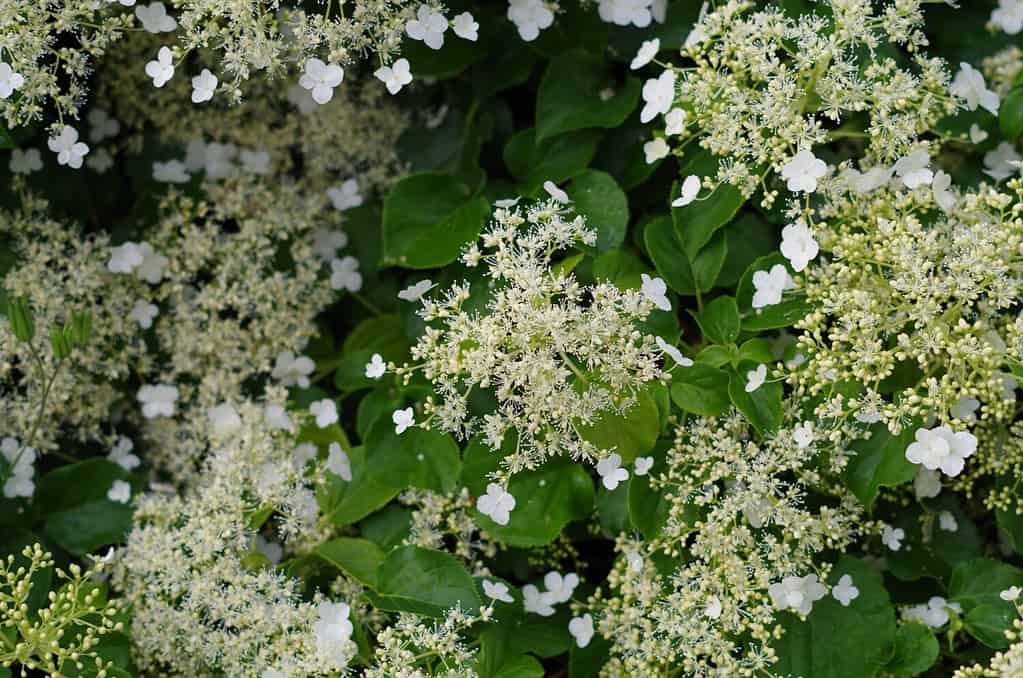
The climbing hydrangea can reach heights over 50 feet and blooms from late spring to fall.
©shadesofquartz/Shutterstock.com
Climbing Hydrangea (Hydrangea anomala subsp. petiolaris)
- Peak Bloom Season: Late spring to fall
- Blooms On: Old wood
- Hardy in These Zones: 4-9, depending on the cultivar
Unlike the more common shrub-like hydrangea varieties, climbing hydrangeas can grow more than 50 feet upward to create vertical garden interest. They’re vigorous climbers that cling to walls, trees, fences, and trellises with aerial rootlets. They also have heart-shaped dark green leaves and produce creamy-white lacecap flowers with inner sterile buds and outer fertile blooms.
Climbing hydrangeas are deciduous, woody flowering vines that tolerate partial shade or filtered sunlight.
When hydrangeas bloom depends mainly on the plant variety.
In general, most hydrangeas bloom between spring and fall in the majority of Hardiness Zones. However, the plant variety makes a big difference due to their growth habits and the amount of sun they need or can tolerate. So always check the cultivar growth habit to determine when hydrangeas bloom in the Zone where you live. And note that areas with extreme temperatures, hot or cold, aren’t the best climates for hydrangea plants.
The photo featured at the top of this post is © Inga Gedrovicha/Shutterstock.com
Thank you for reading! Have some feedback for us? Contact the AZ Animals editorial team.







